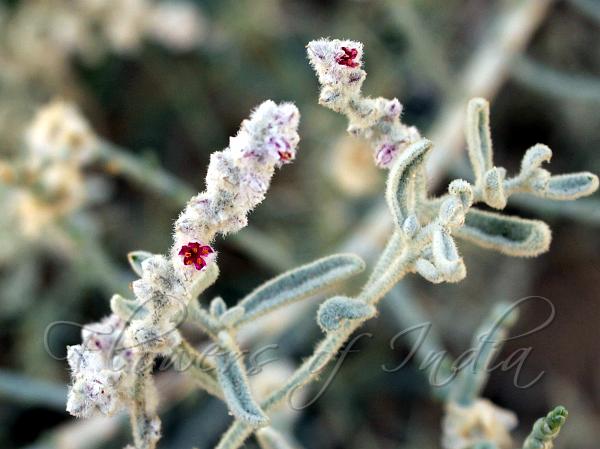|
| Desert Cotton |
|

|

| File size | 648308 |
| Original date | 12/16/17 1:36 PM |
| Resolution | 2048 x 1536 |
| Flash | Flash did not fire, auto |
| Focal length | 39.0mm |
| Exposure time | 1/250s |
| Aperture | 7.1 |
| Focus Distance | |
| Metering Mode | Multi-segment |
| Camera make | Canon |
| Camera model | Canon EOS 700D |
| Sensor type |
|
|
|
|
Photo: |
Botanical name: Aerva javanica Family: Amaranthaceae (Amaranth family)
Synonyms: Aerva ovata, Aerva persica, Aerva tomentosa
Synonyms: Aerva ovata, Aerva persica, Aerva tomentosa
Desert Cotton is a perennial semi-shrubby plant
growing in tropical and subtropical dry areas. It is both erect and
spreading, grows up to a height of 1.5 m high, and is covered with
densely matted hairs on stems and leaves. It is much-branched, with
vigorous round stems that are woody at the base, and a dark stout
taproot. It has numerous leaves, ovate to lanceshaped, 1-2 x 4-7.5 cm,
alternate and white to grey. The flowers are small and whitish and
arranged in dense, woolly at branch-ends panicles. This herb is deep
rooted, and is used as soil binder in desert reclamation. It has a
native distribution incorporating much of Africa (including
Madagascar), and the south-west and south of Asia.
Medicinal uses: In Pakistan, it is used as a
purgative, antidiarrheal and anthelmintic medicine in cattle. In India,
boiled seeds are fed to animals suffering from foot and mouth disease.
In Ethiopia, roots are used to treat ophthalmic infection in goats.
In Pakistan, it is used as a
purgative, antidiarrheal and anthelmintic medicine in cattle. In India,
boiled seeds are fed to animals suffering from foot and mouth disease.
In Ethiopia, roots are used to treat ophthalmic infection in goats.
Medicinal uses:
 In Pakistan, it is used as a
purgative, antidiarrheal and anthelmintic medicine in cattle. In India,
boiled seeds are fed to animals suffering from foot and mouth disease.
In Ethiopia, roots are used to treat ophthalmic infection in goats.
In Pakistan, it is used as a
purgative, antidiarrheal and anthelmintic medicine in cattle. In India,
boiled seeds are fed to animals suffering from foot and mouth disease.
In Ethiopia, roots are used to treat ophthalmic infection in goats.
| Identification credit: Prashant Awale, Siddarth Machado | Photographed near Jaisalmer, Rajasthan & Guttur, Andhra Pradesh. |
• Is this flower misidentified? If yes,